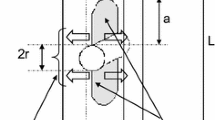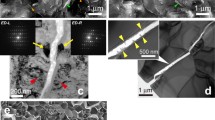Abstract
The growth of indentation-produced “controlled” flaws in a polycrystalline lithium-aluminium-silicate glass ceramic has been studied, over a wide range of temperatures and strain rates. Significant scatter in the fracture stress at elevated temperatures suggests that the extent of slow crack growth is highly sensitive to microstructural details. The initial flaw shape is important inK IC determination. Up to 1000° C the fracture toughness,K IC, is essentially strain-rate insensitive. The value ofK IC decreases with temperature beyond 850° C. Intergranular cavity formation is suggested as the reason. Crack blunting by diffusive crack healing probably occurs at high temperatures. Also, intergranular slow crack growth occurs essentially under Mode I loading.
Similar content being viewed by others
References
D. B. Marshall andB. R. Lawn,J. Mater. Sci. 14 (1979) 2001.
D. B. Marshall, B. R. Lawn andP. Chantikul,ibid. 14 (1979) 2225.
B. R. Lawn andA. G. Evans,ibid. 12 (1977) 2195.
B. R. Lawn andM. V. Swain,ibid. 10 (1975) 113.
F. F. Lange,J. Amer. Ceram. Soc. 57 (1974) 84.
M. G. Mendiratta andJ. J. Petrovic,ibid. 61 (1978) 226.
R. K. Govila, K. R. Kinsman andP. Beardmore,J. Mater. Sci. 13 (1978) 2081.
A. G. Evans andS. M. Wiederhorn,ibid. 9 (1974) 270.
F. F. Lange andJ. L. Iskoe, “Proceedings of the Second Army Materials Technology Conference”, Hyannis, Massachusetts 13–16 November, 1973), edited by J. J. Burke, A. E. Gorum and R. N. Katz (Brook Hill Publishing Co., Chestnut Hill, Mass, 1974) p. 223.
G. K. Bansal,J. Amer. Ceram. Soc. 59 (1976) 87.
J. J. Petrovic andL. A. Jacobson,ibid. 59 (1976) 34.
W. D. Kingery, “Introduction to Ceramics”, (Wiley, New York, 1963).
R. A. Swalin, “Thermodynamics of Solids” (Wiley, New York, 1972).
B. S. Majumdar andS. J. Burns,Acta Met. 29 (1981) 579.
A. G. Evans andE. A. Charles,ibid. 25 (1977) 919.
Author information
Authors and Affiliations
Rights and permissions
About this article
Cite this article
Majumdar, B.S., Mah, T. & Mendiratta, M.G. Flaw growth in a polycrystalline lithium-aluminium-silicate glass ceramic. J Mater Sci 17, 3129–3139 (1982). https://doi.org/10.1007/BF01203475
Received:
Accepted:
Issue Date:
DOI: https://doi.org/10.1007/BF01203475




